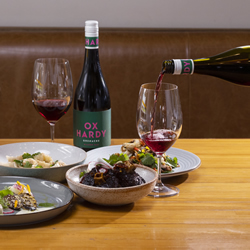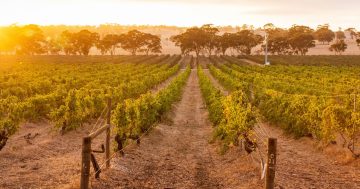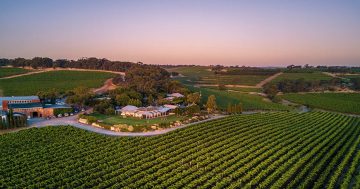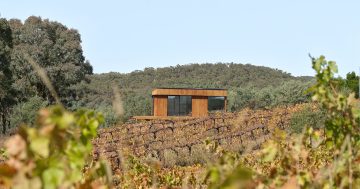By Christine Salins.

Ox Hardy
Grenache has a long history in Australia, having been planted in McLaren Vale in the late 1830s and the Barossa in the early 1840s.
Yet it’s never won the kudos of other reds and for many years was used largely for making port. But now it is having its time in the sun and rightly so, as it produces vibrant, aromatic, easy-drinking wines that go perfectly with food.
This Friday, September 16, is International Grenache Day and to prepare for the occasion, Barossa producer Yalumba hosted a wine tasting with McLaren Vale producer Ox Hardy to look at the similarities and differences in Grenache from the two regions.
In 1999, Yalumba bought the Tri-Centenary vineyard, on the floor of the Barossa Valley. It has a block of 820 gnarly Grenache bush vines that were planted in 1889 and that are used today in the Tri-Centenary Grenache, the pinnacle of the Yalumba Grenache Collection.
The vineyard also has blocks ranging from 40 to 90 years old producing grapes for Yalumba’s Vine Vale Grenache and that make up a portion of the Barossa Bush Vine Grenache. As well as these three wonderful varietals, Yalumba also produces a lovely GSM (Grenache Shiraz Mataro) blend.
Ox Hardy makes just the one McLaren Vale Grenache. Andrew ‘Ox’ Hardy is still waiting for his new plantings to produce so has sourced fruit from some very special dry-grown blocks in the region.

Yalumba Bush Vine Grenache
He describes the current interest in Grenache as “spectacular” and says the bright, aromatic wines of today are very different from those of the past as winemakers explore a new path.
“Not many of us are using small oak (barrels) anymore; it’s all about the purity of fruit and I think that’s really exciting in the long term.” Many of the new plantings were going to cooler climate regions, not just to the Barossa, “and that’s really exciting because that’s going to really push the boundaries”.
Consumers were also showing a willingness to experiment with different styles, he said, turning away from the “big black thumpers” of the past to lighter styles such as Pinot Noir. “The so-called orange wine movement is helping in a way as well. Younger consumers are really getting these trends.”
Yalumba Senior Red Winemaker, Kevin Glastonbury, said a lot of older styles of Grenache were driven by higher pH levels and less acid than today’s easy-drinking styles.
Today’s consumers have the benefit of being able to choose from a range of styles and prices, he said, showing that winemakers were putting effort into Grenache and making it easier for consumers to decide where their tastes lie.
Both winemakers say Grenache is a versatile variety that pairs easily with a wide range of food. Kevin Glastonbury recommends a ploughman’s platter; Andrew ‘Ox’ Hardy thinks yum cha (dumplings, pork buns, salt and pepper squid) work really well. Yalumba’s Jessica Hill-Smith says a cheese board with the Tri-centenary Grenache is the perfect finale.
Ox Hardy 2021 McLaren Vale Grenache, $38: Picked from four small old, dry-grown bush vine blocks, the wine was fermented in oak for 6 months. A bright purple/crimson colour, it is opulent and lush with flavours of cherries and Christmas spices.
Yalumba 2020 Barossa Bush Vine Grenache, $28: From Yalumba’s Samuel’s Collection, Bush Vine has all the bright flavours and aromas expected of a Barossa Grenache. Plums and cherries on the nose give way to a generous fruit-driven palate of raspberries, cherries and velvety tannins.
Yalumba 2021 Vine Vale Grenache, $40: From Yalumba’s Distinguished Sites Collection, this has been a star performer for Yalumba over the past couple of years. From blocks planted in 1929 and 1949, it is highly aromatic with complex earthy, savoury notes and hints of pomegranate, pepper and spice.
Yalumba 2019 The Tri-Centenary Grenache, $65: Just 2500 bottles were produced of Yalumba’s flagship Grenache which comes from a Barossa vineyard planted in 1889. With a subtle elegance, this medium-bodied wine has strawberry and plum notes with a hint of licorice and chocolate. Unusually, the wine spent 149 days on skins and had no oak treatment, not uncommon in white winemaking but less common in premium reds.







